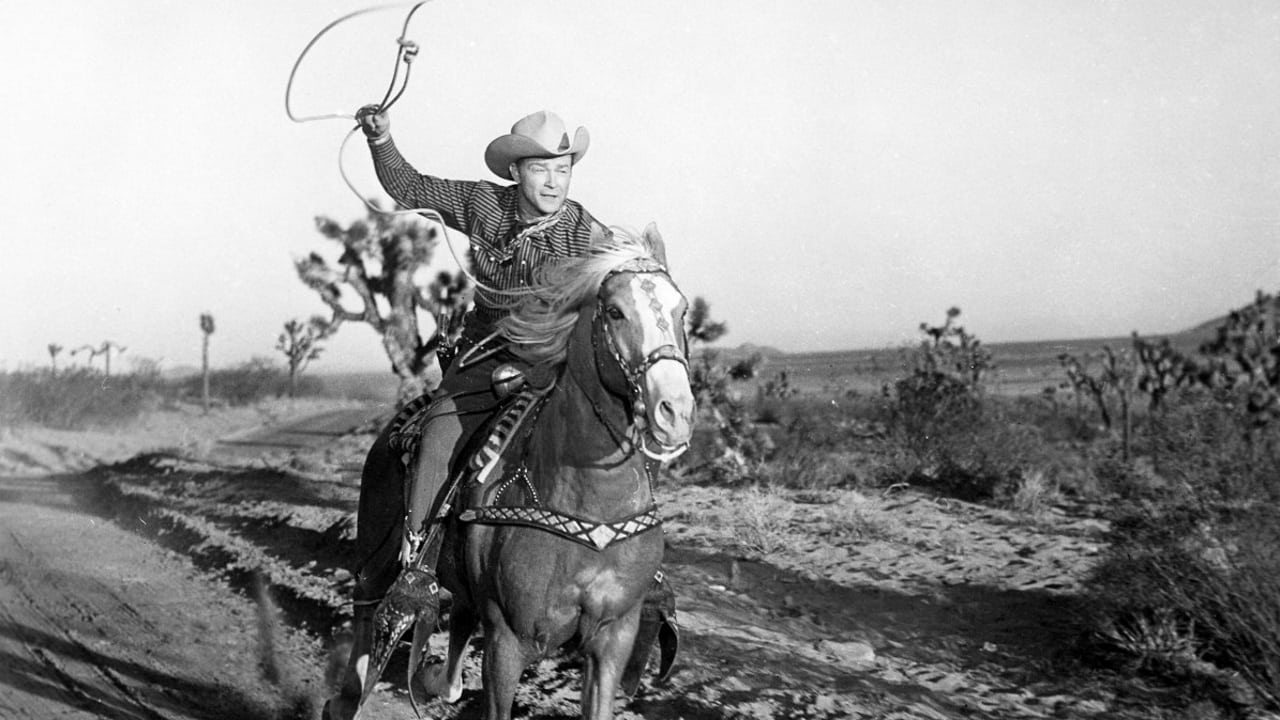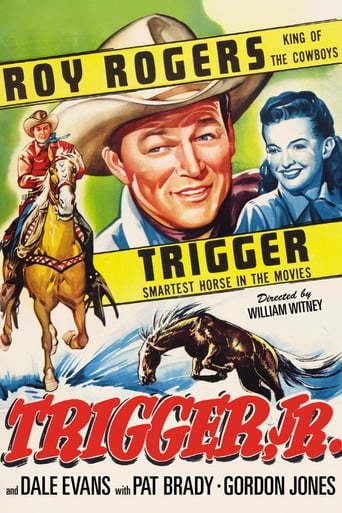

A windstorm sidetracks singing cowboy Roy Rogers (as Roy Rogers) and his traveling "Rogers Western Show" carnival. The Rogers troupe - including faithful horse "Trigger" and titular offspring "Trigger Jr." - set up camp at the Harkrider Ranch. Rogers and company form an immediate bond with the Harkriders - perky Dale Evans (as Kay), preteen Peter Miles (as Larry), and grandpa George Cleveland. Nasty racketeers led by Grant Withers (as Mason) mean danger and adventure for Rogers and his friends...The King of the Cowboys continued to reign in filmgoers in the fifties, with this vivid "Truecolor" entry directed by William Witney being one of the better entries. These films were made very quickly and never intended to be art, but modern viewers can become enchanted here and there (as in the past). "Trigger, Jr." is inappropriately titled - "The Phantom Stallion" would have been better - but it accentuates the lush, dream-like quality of many by including an effective nightmare, had by young Miles.Miles' nightmarish dream includes the blinded "Trigger", who had earlier donned a downright creepy looking mask. Also noteworthy is the characterization given Miles, who "gets more like his father every day," a "worthless, no account drifter." This description comes from grandfather Cleveland, who is introduced as lovable, and from a wheelchair. However, his character is more darkly complex, and his disability not at all contrived. Frequent Rogers director Witney corrals it well, with good action and stunt work.****** Trigger, Jr. (6/30/50) William Witney ~ Roy Rogers, Dale Evans, Gordon Jones, Peter Miles
... View MoreTrigger, Jr. finds Roy Rogers heading a traveling circus that is looking to put up at Dale Evans ranch for winter quarters. Unfortunately her father George Cleveland owns the place and he's an old circus man himself who's sworn off the sawdust. Still he lets them stay for a bit.Turns out he needs Roy around because he's in a battle with Grant Withers of the Range Patrol. Withers has himself a real nice protection racket going. Those ranches who don't employ him somehow keep losing their stock. Withers during the course of the film employs the services of a killer white stallion that was a former army horse that the army ordered destroyed. Trigger tangles with the horse they call the Phantom and is injured and has hysterical blindness in their first encounter. Guess who wins the return bout. Here's a hint, think Louis and Schmeling.Roy and Dale really do take a back seat to Trigger and his problems in this film. They do however get to sing a very nice duet entitled May the Good Lord Take A Liking To You which sold a few records back in the day. I have it on one of my old record albums. Roy did all right in the recording field, but never was a blockbuster best seller the way his singing cowboy rival Gene Autry was.It's not a bad film, but Trigger really should have been billed first.
... View MoreVeteran B movie director William Witney still had what it takes in 1950 to turn this Dale Evans/Roy Rogers vehicle into a memorable and pleasant outing for all concerned.Roy is a travelling horse carnival man who winters with a cantankerous old man (George Cleveland) who disapproves of his son (young Peter Miles), a boy who's become afraid of horses after his mother's death in a freak accident. In a nice touch relaying the age of the dying West, Roy and his friends go to a horse auction held by an army relay station. There they see a dangerous white stallion who's been condemned to die for his violence against other horses. They attempt to buy the deadly stallion for use in their show, but are assured by the doctor (I. Stanford Jolley) that the horse must die. However Jolley, who is about to lose his job with the relay station, makes a deal with an unscrupulous rancher to keep the horse alive. The rancher then sets the horse on his competitor's ranches and urges them to buy his protection so they will be safe. It's up to the boy to overcome his fear of horses in time to rescue Roy and the others.The photography by Jack Marta is arguably reason enough to watch the film -- the set designers have filled every scene with rich and vibrant colors and everything is framed perfectly. The most exceptional aspect of the film IMHO is the music, some of which is well written. I particularly enjoyed both the music and staging of "Stampede".
... View MoreIn my opinion, Roy Rogers's best B-Westerns were the ones in the late forties-early fifties that were directed by William Witney, the "action ace." Of these Witney-Rogers ones, TRIGGER JR. is one of the best. Roy, Trigger, Trigger's almost-full grown son Trigger Jr., sidekicks Gordon Jones and Pat Brady, Foy Willing and the Riders of the Purple Sage, along with Roy's circus/wild west show, arrive at the ranch of Colonel Harkrider (veteran character actor George Cleveland), formerly partners with Roy's father Jonathan Rogers in the circus. They wish to winter at the ranch, as it is circus press agent Splinter's (Jones) idea that this will get the circus free publicity. The Colonel's daughter Kay (Dale Evans) also hopes that the prescence of the circus will get vigor back in her father, and that he will resume command of the circus when it leaves in the spring. The Colonel, however, is not too keen on circus life since the death of his older daughter during her bareback riding act. Her son, young Larry (Peter Miles) has ever since been afraid of horses, and the Colonel considers him a coward. The villain of the piece is Manson (Grant Withers), head of the so-called "Range Patrol" which is supposed to keep ranchers' horses from straying onto neighbouring ranges and prevent wild horse from making off with the herds. However, they have accomplished nothing, charged the ranchers exorbitant fees, and they are even suspected of rustling horse. Therefore, the Colonel wants to call together the ranchers to ask for a disbandment of the Range Patrol. Manson, who, needless to say, is rustling while collecting his huge fees, does not want his nice little racket to be wrecked, so he arranges for the escape of a vicious wild hores which the ranchers had ordered destroyed, and turns it loose on the ranchers' stock. The "Phantom" as the killer horse comes to be called, begins vicious raids on the ranch horses, striking them down and killing them with his hoofs. Just as Manson had planned, this gives his Range Patrol an excuse to stay around and "protect" the ranches from the Phantom. How Roy, Trigger Sr. and Jr., the Harkriders, Splinter, and the Riders of the Purple Sage defeat Manson's schemes makes for masterful entertainment. Both Trigger and little Larry prove key factors in the defeat of Manson, and he and his horse are finally brought to bay. This movie has plenty of action, comedy, and drama. Some of the action, such as a violent "hoof fight" between Trigger and the Phantom, is unique and not usually found in B-Westerns. Music is not as well represented as in Roy's earlier films such as BELLS OF ROSARITA, as there are only three songs, but there is nothing wrong with that. And two of the songs are, in my opinion, among the best of the ballads rendered by Roy. They are the delightfully informal "May the good Lord take a likin' to ya" and the eriee and haunting "Stampede!" So two thumbs-up for TRIGGER JR., Roy, Dale, Wit--and Trigger, of course.
... View More